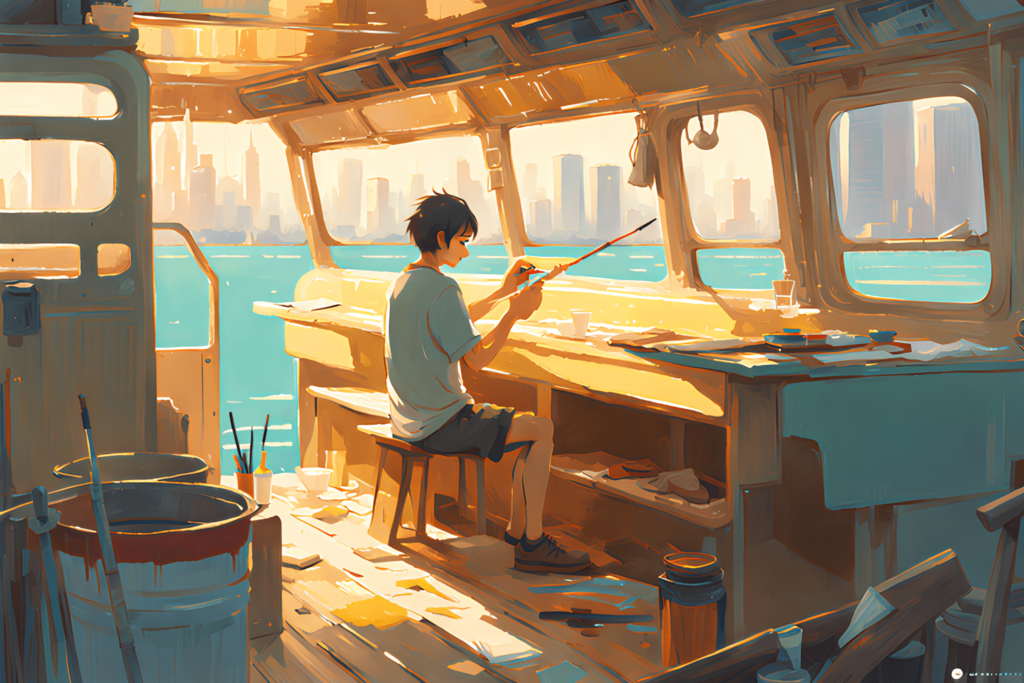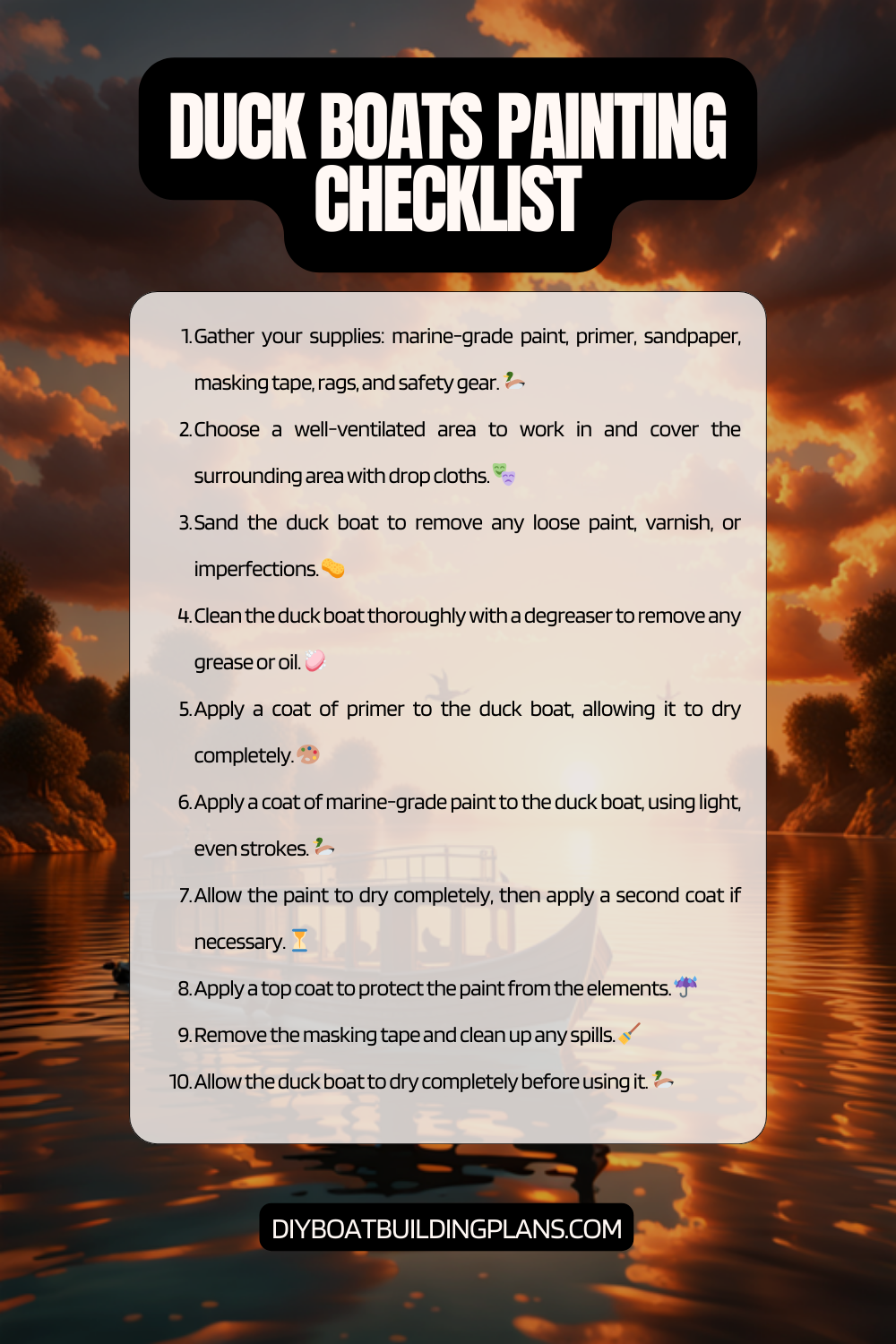Overview of Duck Boat Painting Tips
Maintaining the paint job on a duck boat is of utmost importance for several reasons. Firstly, a well-painted duck boat not only enhances its aesthetic appeal but also protects it from the harsh elements it encounters in its natural habitat. The paint acts as a barrier against water, UV rays, and saltwater, preventing corrosion and damage to the boat’s structure. Additionally, a well-maintained paint job can increase the lifespan of the boat, ensuring that it remains in top condition for years to come.
A well-painted duck boat offers numerous benefits to its owner. Firstly, it provides camouflage in the natural surroundings, allowing hunters to blend in seamlessly with their environment. This can significantly increase their chances of success during hunting expeditions. Moreover, a well-painted duck boat can also serve as a deterrent to potential predators, as it mimics the appearance of other waterfowl and reduces the risk of being detected. Overall, a well-painted duck boat not only enhances its functionality but also adds value to the overall hunting experience.
Key Takeaways
- Choose the right paint for your duck boat to ensure longevity and protection from the elements.
- Proper preparation, including sanding and priming, is crucial for achieving a smooth and professional-looking finish.
- Consider using stencils and decals for custom designs on your duck boat.
- Protect your duck boat from UV rays and saltwater to maintain its paint job.
- Avoid common mistakes, such as rushing the process or using the wrong type of paint, when painting your duck boat.

Choosing the Right Paint for Your Duck Boat
When it comes to choosing the right paint for your duck boat, there are several factors to consider. Firstly, you need to select a paint that is specifically designed for marine applications. Marine paints are formulated to withstand constant exposure to water, UV rays, and saltwater, ensuring long-lasting protection for your boat. Additionally, marine paints are often available in a range of colors that mimic the natural surroundings, allowing you to achieve optimal camouflage.
Another important factor to consider when choosing paint is its durability and resistance to abrasion. Duck boats are often subjected to rough conditions, including rocks and debris in the water. Therefore, it is crucial to select a paint that can withstand these challenges without chipping or peeling easily. Additionally, consider the ease of application and maintenance when choosing paint for your duck boat. Opt for a paint that is easy to apply and touch up, as this will save you time and effort in the long run.
Preparing Your Duck Boat for Painting
Before you can start painting your duck boat, it is essential to prepare the surface properly. Begin by thoroughly cleaning the boat to remove any dirt, grime, or residue that may interfere with the adhesion of the paint. Use a mild detergent and water solution to scrub the surface, ensuring that all areas are clean and free from contaminants. Rinse the boat thoroughly and allow it to dry completely before proceeding to the next step.
Next, remove any old paint from the boat’s surface. This can be done using a paint stripper or sanding technique, depending on the condition of the existing paint. If the old paint is in good condition, a light sanding may be sufficient to create a smooth surface for the new paint to adhere to. However, if the old paint is peeling or damaged, it is recommended to use a paint stripper to remove it completely. Be sure to follow the manufacturer’s instructions when using a paint stripper and take necessary safety precautions.
After removing the old paint, inspect the boat for any damages that need repair. Fill in any cracks, dents, or holes using an appropriate marine-grade filler. Allow the filler to dry completely and sand it down until it is smooth and level with the surrounding surface. This step is crucial as it ensures a seamless finish and prevents any water from seeping into the boat’s structure.
Sanding Techniques for a Smooth Finish
| Sanding Technique | Description | Advantages | Disadvantages |
| Hand Sanding | Sanding by hand using sandpaper or sanding blocks. | Controlled sanding, good for small areas, inexpensive. | Time-consuming, can cause uneven sanding, can be tiring. |
| Power Sanding | Sanding using a power tool such as an orbital sander or belt sander. | Efficient, saves time, good for large areas. | Can be expensive, can cause damage if not used properly, can be noisy. |
| Wet Sanding | Sanding using water to lubricate the sandpaper and reduce dust. | Produces a smooth finish, reduces dust, good for finishing coats. | Can be messy, requires more time and effort, can cause rust if not dried properly. |
| Dry Sanding | Sanding without water or lubrication. | Good for rough sanding, can be done quickly, less messy. | Produces more dust, can cause scratches, not suitable for finishing coats. |
Sanding plays a crucial role in achieving a smooth and professional-looking finish on your duck boat. It helps create a clean surface for the new paint to adhere to and removes any imperfections or rough spots on the boat’s surface. When sanding your duck boat, it is important to use the right techniques and tools for optimal results.
Start by selecting the appropriate grit sandpaper for the job. For initial sanding, a coarse grit sandpaper, such as 80 or 120, can be used to remove any rough areas or old paint. As you progress, switch to a finer grit sandpaper, such as 220 or 320, to achieve a smoother finish. It is important to sand in a consistent and even manner, applying light pressure and using long, smooth strokes. This will help avoid uneven surfaces and ensure a uniform finish.
In addition to hand sanding, consider using power tools such as an orbital sander or a random orbital sander for larger areas. These tools can save time and effort while providing an even and consistent sanding pattern. However, exercise caution when using power tools to avoid damaging the boat’s surface or creating deep scratches.
Priming Your Duck Boat for Longevity
Priming your duck boat is a crucial step in the painting process as it provides a strong foundation for the paint and enhances its longevity. Primers act as a bonding agent between the boat’s surface and the paint, ensuring better adhesion and durability. They also help seal the surface, preventing moisture from penetrating and causing damage.
When selecting a primer for your duck boat, opt for a marine-grade primer that is specifically designed for use in watercraft applications. Marine primers are formulated to withstand the harsh conditions encountered by boats, including exposure to water, UV rays, and saltwater. Additionally, choose a primer that is compatible with the type of paint you intend to use.
Before applying the primer, ensure that the boat’s surface is clean and free from any dust or debris. Apply the primer in thin, even coats using a brush or spray gun, following the manufacturer’s instructions for drying time between coats. It is important to apply multiple thin coats rather than one thick coat to achieve optimal adhesion and coverage. Allow the primer to dry completely before proceeding to the next step.
Applying Paint with a Brush or Spray Gun
When it comes to applying paint to your duck boat, you have the option of using a brush or a spray gun. Each method has its pros and cons, and the choice depends on personal preference and the desired finish.
Using a brush allows for more control and precision, especially when painting intricate areas or details. It also allows you to work at your own pace and easily touch up any missed spots. However, using a brush can result in visible brush strokes if not applied correctly. To minimize brush strokes, use long, smooth strokes and avoid overworking the paint. Additionally, consider using a high-quality marine-grade brush that is specifically designed for use with boat paint.
On the other hand, using a spray gun provides a faster and more even application of paint, especially for larger areas. It can also result in a smoother finish without visible brush strokes. However, using a spray gun requires practice and skill to achieve optimal results. It is important to follow the manufacturer’s instructions for the spray gun and adjust the settings accordingly. Additionally, ensure proper ventilation and wear appropriate safety gear when using a spray gun.
Tips for Achieving a Professional-Looking Paint Job
Achieving a professional-looking paint job on your duck boat requires attention to detail and careful execution. Here are some tips to help you achieve optimal results:
1. Prepare the surface properly: Thoroughly clean, sand, and prime the boat’s surface before applying paint. This ensures better adhesion and a smoother finish.
2. Use high-quality materials: Invest in high-quality marine-grade paints, primers, brushes, or spray guns for better durability and longevity.
3. Apply multiple thin coats: Instead of applying one thick coat of paint, apply multiple thin coats for better coverage and adhesion.
4. Follow the manufacturer’s instructions: Read and follow the instructions provided by the paint manufacturer for optimal results. This includes drying times, application techniques, and safety precautions.
5. Work in a clean and controlled environment: Choose a well-ventilated area with minimal dust or debris to avoid contamination of the paint job.
6. Take your time: Rushing the painting process can lead to mistakes and an uneven finish. Take your time, be patient, and allow each coat to dry completely before applying the next.
Using Stencils and Decals for Custom Designs
If you want to add a personal touch or custom design to your duck boat, using stencils and decals can be a great option. Stencils allow you to create intricate patterns or designs on the boat’s surface, while decals offer pre-designed graphics or images that can be easily applied.
Using stencils requires careful planning and execution. Start by selecting the desired design or pattern and ensure that it is appropriately sized for your boat. Cut out the stencil using a sharp knife or stencil cutter, ensuring clean edges. Secure the stencil to the boat’s surface using masking tape or adhesive spray, making sure it is positioned correctly. Apply paint using a brush or spray gun, being careful not to oversaturate the stencil. Once the paint is dry, carefully remove the stencil to reveal the design.
Decals offer a simpler alternative for adding custom designs to your duck boat. They are pre-designed graphics or images that can be easily applied to the boat’s surface. Clean the area where you want to apply the decal thoroughly and ensure it is dry. Peel off the backing paper from the decal and carefully position it on the boat’s surface. Smooth out any air bubbles or wrinkles using a squeegee or your fingers. Once applied, press down firmly to ensure proper adhesion.
Protecting Your Duck Boat from UV Rays and Saltwater
Protecting your duck boat’s paint job from the damaging effects of UV rays and saltwater is crucial for its longevity. UV rays can cause the paint to fade and deteriorate over time, while saltwater can lead to corrosion and damage to the boat’s structure. To protect your duck boat, consider using protective coatings specifically designed for marine applications.
One popular option is a clear coat or topcoat that provides an additional layer of protection over the paint. Clear coats are formulated to withstand UV rays, saltwater, and other environmental factors, ensuring that the paint job remains vibrant and intact for longer periods. Apply the clear coat according to the manufacturer’s instructions, ensuring proper coverage and drying time.
Another option is using a marine-grade wax or polish. These products create a protective barrier on the boat’s surface, preventing UV damage and repelling saltwater. Apply the wax or polish using a soft cloth or applicator pad, following the manufacturer’s instructions for best results. Regularly reapply the wax or polish to maintain optimal protection.
Download over 500 Boat Plans. Click on the link below.
-->Click Here<--
Maintaining Your Duck Boat’s Paint Job
To ensure the longevity of your duck boat’s paint job, regular maintenance is essential. Here are some tips to help you maintain the paint job:
1. Clean regularly: Wash your duck boat regularly with mild detergent and water to remove dirt, grime, and salt residue. Avoid using abrasive cleaners or brushes that can damage the paint.
2. Touch up as needed: Inspect your boat regularly for any chips, scratches, or areas of paint wear. Touch up these areas promptly using matching paint to prevent further damage.
3. Avoid harsh chemicals: Avoid using harsh chemicals or solvents on your duck boat as they can damage the paint. Stick to mild detergents and cleaners specifically designed for marine applications.
4. Store properly: When not in use, store your duck boat in a dry and covered area to protect it from the elements. If storing outdoors, use a boat cover to shield it from UV rays and prevent water from pooling on the surface.
5. Regularly inspect for damage: Inspect your duck boat for any signs of damage, such as cracks, dents, or corrosion. Address these issues promptly to prevent further damage to the paint job and the boat’s structure.
Common Mistakes to Avoid When Painting Your Duck Boat
While painting your duck boat, it is important to be aware of common mistakes that can compromise the quality of the paint job. Here are some mistakes to avoid:
1. Insufficient surface preparation: Failing to properly clean, sand, and prime the boat’s surface can result in poor adhesion and a subpar finish.
2. Rushing the process: Painting requires patience and attention to detail. Rushing the process can lead to uneven coverage, visible brush strokes, or missed spots.
3. Applying too thick of a coat: Applying a thick coat of paint can result in drips, runs, and an uneven finish. It is better to apply multiple thin coats for better coverage and adhesion.
4. Neglecting proper ventilation: When using paint or primers, ensure proper ventilation in the workspace to avoid inhaling harmful fumes. Use fans or open windows to improve air circulation.
5. Ignoring safety precautions: Always wear appropriate safety gear, such as gloves, goggles, and a respirator when working with paint or chemicals. Follow the manufacturer’s instructions for safe handling and disposal.
Duck Boat Painting Checklist

Conclusion – Duck Boat Painting Tips
In conclusion, maintaining a well-painted duck boat is crucial for both its aesthetic appeal and functionality. A well-painted duck boat not only enhances camouflage but also protects the boat from water, UV rays, and saltwater damage. When painting your duck boat, choose marine-grade paints and primers that are specifically designed for watercraft applications.
Proper surface preparation, including cleaning, sanding, and priming, is essential for achieving a smooth and durable finish. Consider using a brush or spray gun for application, depending on your preference and the desired finish. Pay attention to detail and follow the manufacturer’s instructions for optimal results.
Using stencils and decals can add a personal touch to your duck boat, while protective coatings help safeguard the paint job from UV rays and saltwater. Regular maintenance, including cleaning and touch-ups, is crucial for preserving the paint job’s longevity. By avoiding common mistakes and following these tips, you can achieve a professional-looking paint job that enhances the overall appearance and performance of your duck boat.
FAQs – Duck Boat Painting Tips
What are duck boats?
Duck boats are watercraft that are designed to be used for hunting waterfowl. They are typically small, flat-bottomed boats that are powered by an outboard motor.
Why is painting a duck boat important?
Painting a duck boat is important because it helps to protect the boat from the elements and can help to camouflage it when hunting waterfowl.
What kind of paint should I use to paint my duck boat?
You should use a paint that is specifically designed for use on boats. These paints are typically formulated to be resistant to water, UV rays, and other environmental factors.
What colors should I use to paint my duck boat?
The colors you use to paint your duck boat will depend on the environment in which you will be hunting. Generally, you should use colors that will help to camouflage the boat in the water and blend in with the surrounding vegetation.
How should I prepare my duck boat for painting?
Before painting your duck boat, you should clean it thoroughly and remove any old paint or other debris. You should also sand the surface of the boat to create a smooth, even surface for the new paint to adhere to.
Can I paint my duck boat myself, or should I hire a professional?
You can paint your duck boat yourself if you have the necessary skills and equipment. However, if you are not confident in your ability to do so, it may be best to hire a professional to ensure that the job is done correctly.



